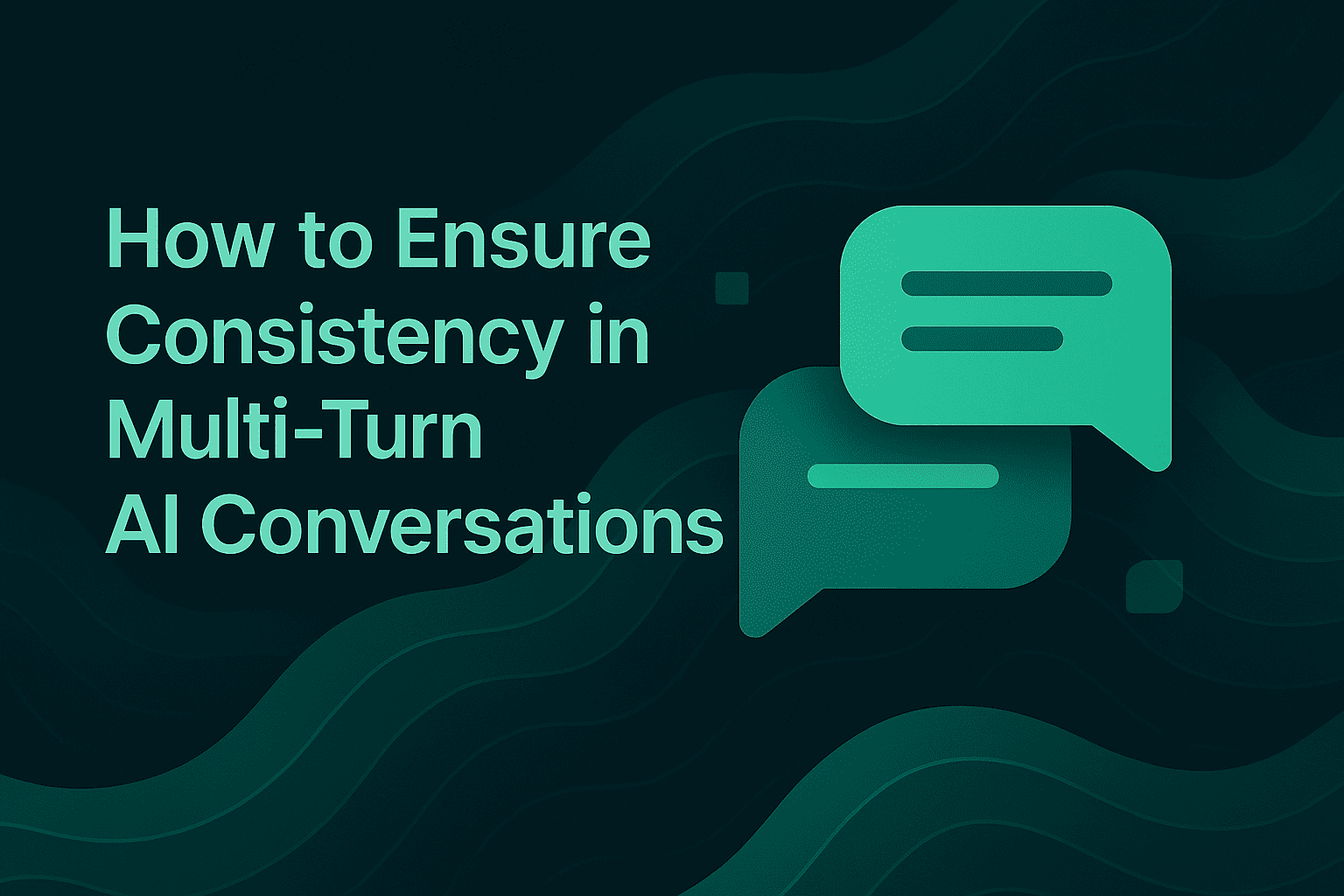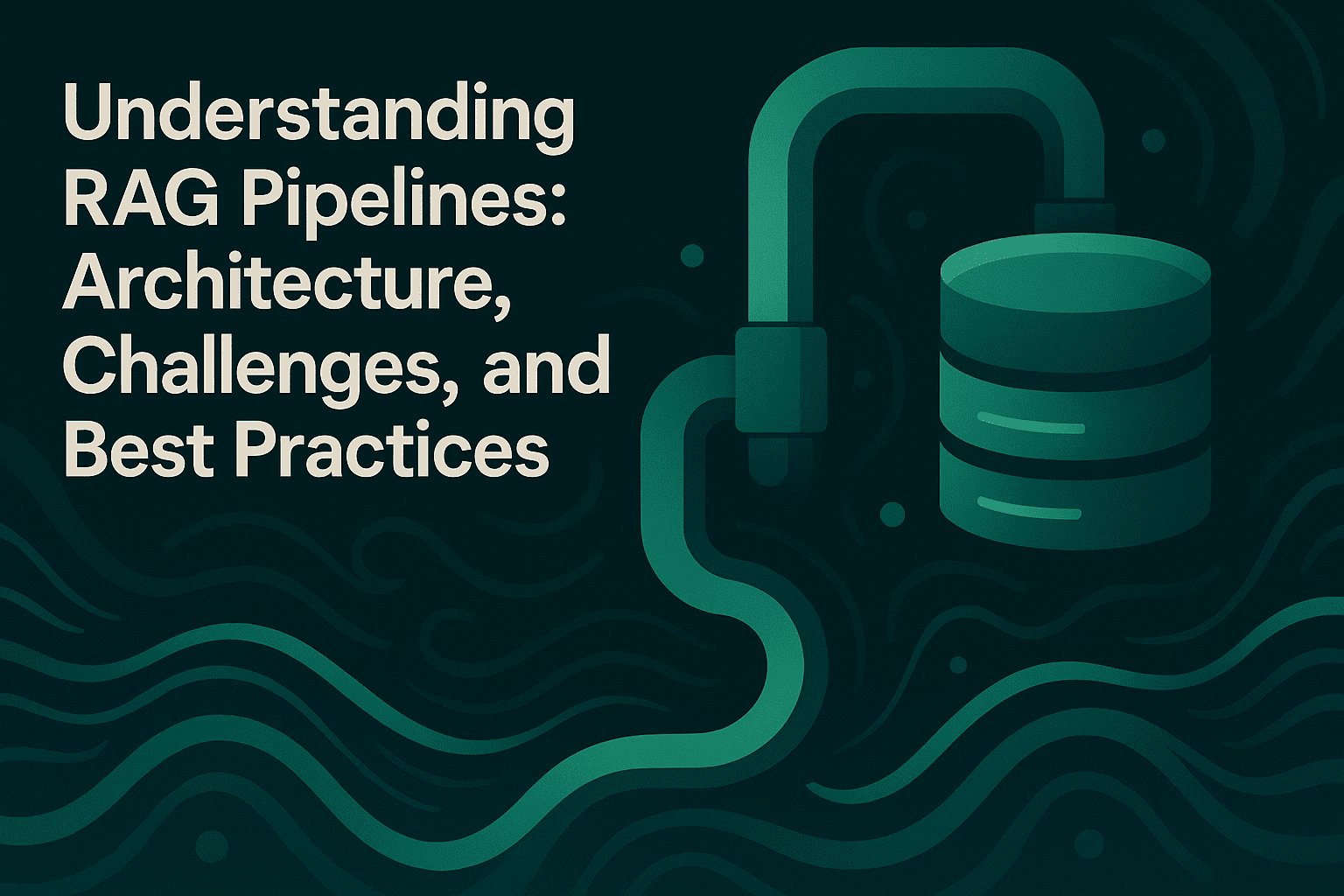How to Ensure Consistency in Multi-Turn AI Conversations

Multi-turn conversations represent one of the most challenging aspects of building reliable AI agents. While large language models demonstrate impressive capabilities in isolated interactions, maintaining consistency across extended dialogues remains a critical challenge for AI engineers. Research shows that leading LLMs exhibit significantly lower performance in multi-turn conversations than single-turn settings, with an average performance drop of 39% across generation tasks.
This degradation isn't just a technical curiosity. For production AI applications, inconsistent multi-turn behavior translates directly to poor user experiences, abandoned interactions, and reduced trust in AI systems. Understanding how to ensure consistency across conversational turns is essential for teams building customer service agents, technical support systems, or any AI application requiring sustained dialogue.
Why Multi-Turn Consistency Matters
Multi-turn consistency goes beyond simply maintaining context. It encompasses several critical dimensions that determine whether an AI agent delivers reliable, coherent interactions across extended conversations.
The Cost of Inconsistency
When AI agents fail to maintain consistency, the consequences manifest in multiple ways. Studies analyzing 200,000+ simulated conversations reveal that models often make premature assumptions in early turns and fail to recover when those assumptions prove incorrect. This "getting lost in conversation" phenomenon occurs when agents overly rely on early decisions, creating a cascading effect that degrades subsequent responses.
The impact extends to production systems where inconsistent agents repeat questions users have already answered, contradict their own previous statements, or forget critical context shared earlier in the conversation. These failures directly undermine user trust and satisfaction, making multi-turn consistency a fundamental requirement rather than an enhancement.
Key Consistency Dimensions
Comprehensive evaluation frameworks identify several dimensions critical to multi-turn consistency:
Contextual continuity ensures agents maintain awareness of conversation history and use prior information appropriately in subsequent responses. This includes properly handling pronouns, references, and implicit context that builds across turns.
Factual consistency requires agents to avoid contradicting information they previously provided or that users shared. A multi-turn evaluation survey emphasizes that maintaining factual alignment across extended conversations remains one of the most challenging aspects of conversational AI.
Task progression involves agents maintaining focus on user goals throughout the conversation, properly tracking subtasks, and building toward task completion rather than losing thread or changing direction arbitrarily.
Persona adherence ensures agents maintain consistent communication styles, knowledge boundaries, and behavioral patterns throughout interactions, avoiding jarring shifts that break conversational flow.
Common Challenges in Multi-Turn Consistency
AI engineers building conversational systems encounter several technical challenges that directly impact multi-turn consistency. Understanding these challenges enables teams to implement targeted solutions.
Context Window Management
Context windows constrain AI applications in ways that significantly impact multi-turn consistency. As conversations extend, accumulated history consumes increasing amounts of the available context window. Each exchange adds user input, agent responses, and any intermediate reasoning or tool outputs to the conversation state.
The challenge intensifies for agents using chain-of-thought prompting or other reasoning frameworks. While these techniques improve output quality, they consume substantial context with intermediate reasoning steps. Teams must balance the benefits of detailed reasoning against context capacity constraints.
Research on long-context evaluation demonstrates that model performance degrades significantly as context length increases, even for models claiming to support long contexts. This degradation occurs because longer contexts introduce more opportunities for the model to lose track of critical information or become confused by less relevant details.
Memory and State Management
Stateless LLM APIs require applications to manually manage and transmit conversation history with each request. This architecture places responsibility for memory management entirely on the application layer, creating several consistency risks.
Without proper state management, agents may lose track of user preferences, forget decisions made in earlier turns, or fail to maintain awareness of the current task context. Conversational memory benchmarks demonstrate that existing systems struggle with temporal consistency and knowledge updates across extended interactions.
Effective memory management must balance completeness with efficiency. Including too much conversation history increases latency and costs while potentially degrading performance. Including too little history causes agents to lose critical context. Finding the right balance requires understanding which information remains relevant as conversations progress.
Information Retrieval Challenges
For agents with access to external knowledge sources or long conversation histories, retrieval quality directly impacts multi-turn consistency. When context exceeds available capacity, systems must decide what information to retain and what to discard or summarize.
Poor retrieval decisions cascade through the conversation. If an agent fails to retrieve relevant prior context, it may repeat questions, provide contradictory information, or lose track of user goals. Studies on multi-turn agent evaluation show that retrieval accuracy significantly influences overall consistency metrics.
Best Practices for Ensuring Multi-Turn Consistency
Maintaining consistency in multi-turn conversations requires deliberate architectural decisions and careful implementation across multiple system layers.
Strategic Context Management
Effective context management begins with prioritizing the most relevant information for each conversation turn. Rather than attempting to include all conversation history, successful implementations identify which information actively contributes to maintaining consistency.
Context engineering strategies include selective context injection, where systems analyze conversation state to determine which prior turns remain relevant. This approach avoids context bloat while ensuring critical information persists throughout the conversation.
Hierarchical summarization provides another effective strategy. Systems can maintain detailed recent history while summarizing older conversation segments. This balances completeness with efficiency, allowing agents to access both immediate context and longer-term conversation patterns without overwhelming the context window.
Role-based context filtering optimizes context usage in multi-agent systems. Each agent receives context tailored to its specific function, reducing unnecessary information while ensuring agents have access to relevant conversation history for their tasks.
Prompt Engineering for Consistency
Well-crafted prompts significantly influence multi-turn consistency. Effective prompts explicitly instruct agents on how to maintain consistency across turns.
Prompts should include clear instructions about referencing prior conversation history, maintaining factual consistency, and avoiding contradictions. Providing examples of consistent multi-turn behavior helps agents understand expected patterns.
For task-oriented conversations, prompts should emphasize tracking user goals and maintaining focus throughout extended interactions. This helps prevent agents from losing thread or prematurely concluding tasks.
Structured output formats can enhance consistency by requiring agents to explicitly acknowledge prior context before generating responses. This forces agents to actively consider conversation history rather than treating each turn in isolation.
Architectural Patterns
System architecture fundamentally shapes consistency capabilities. Several architectural patterns have proven effective for multi-turn applications.
Session management systems maintain conversation state across multiple user interactions, ensuring agents have access to complete conversation context. Proper session management includes handling timeout scenarios, managing session transitions, and supporting conversation resumption.
Memory systems augment context windows by storing and retrieving relevant information from conversation history. Effective memory architectures include mechanisms for importance scoring, temporal decay, and relevance-based retrieval.
For complex workflows, state machines provide explicit tracking of conversation progress. State machines define valid conversation states and transitions, helping agents maintain consistent behavior and avoid invalid state transitions that break conversational flow.
Multi-agent frameworks leverage specialized agents for different conversation aspects, with coordination mechanisms ensuring consistency across agent interactions. This architectural pattern enables sophisticated behaviors while maintaining clear responsibility boundaries.
Evaluation and Testing Strategies
Ensuring multi-turn consistency requires systematic evaluation that goes beyond single-turn metrics. Production-ready systems need comprehensive testing frameworks that capture consistency failures before they reach users.
Session-Level Evaluation
Effective multi-turn evaluation combines session-level and node-level metrics. Session-level evaluation assesses whether agents achieve conversation goals while maintaining consistency throughout the interaction.
Key session-level metrics include:
Task completion rate measures whether agents successfully complete user goals across multi-turn conversations. This metric reveals whether consistency issues prevent agents from reaching conversation objectives.
Conversation coherence assesses how well agent responses connect to and build upon previous turns. Coherence scoring evaluates whether conversations maintain logical flow and contextual relevance.
Consistency index tracks contradictions and factual errors across conversation turns, typically expressed as a percentage of consistent statements relative to total statements made.
Simulation-Based Testing
Agent simulation enables teams to test multi-turn consistency across hundreds of scenarios before production deployment. Simulation frameworks generate realistic conversation patterns spanning multiple user personas and interaction styles.
Effective simulation strategies include:
Creating diverse conversation scenarios that stress-test agent capabilities across various contexts, conversation lengths, and complexity levels. This reveals consistency issues that might not surface in limited manual testing.
Implementing synthetic user personas that maintain consistent behavior patterns across multiple conversation turns. Persona-driven simulation helps identify when agents fail to adapt appropriately to different user types.
Defining success criteria that specifically target consistency dimensions. Rather than only measuring task completion, simulations should explicitly evaluate whether agents maintain factual accuracy, contextual awareness, and persona adherence throughout conversations.
Node-Level Analysis
While session-level metrics reveal overall consistency, node-level analysis helps teams diagnose specific failure points. Detailed evaluation frameworks track individual agent actions, tool calls, and decision points throughout conversations.
Node-level metrics include:
Retrieval accuracy measures whether agents successfully retrieve relevant context from conversation history when needed. Poor retrieval accuracy directly causes consistency failures.
Tool usage appropriateness assesses whether agents select and use tools consistently throughout conversations. Inconsistent tool usage patterns indicate potential reliability issues.
Response latency distribution reveals whether consistency degradation correlates with performance issues. Unexpectedly slow responses may indicate context management problems.
LLM-as-a-Judge Evaluation
LLM-as-a-Judge approaches provide scalable qualitative assessment for multi-turn conversations. Well-designed rubrics enable evaluator models to assess dimensions like clarity, faithfulness, and coherence at scale.
Effective LLM-as-a-Judge implementations include clear evaluation criteria, specific examples of good and poor consistency, and structured output formats that ensure reliable scoring. This approach bridges the gap between purely automated metrics and expensive manual review.
Production Monitoring
Multi-turn consistency requires ongoing monitoring in production environments. Observability systems track real-time conversation quality and run periodic evaluations to identify consistency degradation.
Production monitoring should include:
Automated evaluations that continuously assess consistency metrics on production conversations, enabling teams to detect quality regressions quickly.
Distributed tracing that captures complete conversation flows, allowing engineers to identify where consistency breaks down in complex multi-agent systems.
Real-time alerting on consistency violations, such as detected contradictions or failures to maintain context, enabling rapid response to production issues.
Building Consistent Multi-Turn Agents
Multi-turn consistency represents a fundamental challenge in conversational AI, requiring deliberate architectural decisions, careful implementation, and comprehensive evaluation. Teams that systematically address context management, implement robust testing frameworks, and maintain ongoing observability can build agents that reliably maintain consistency across extended conversations.
Success in multi-turn consistency requires treating it as a first-class requirement throughout the development lifecycle. From initial design through production deployment and monitoring, consistency considerations should inform architectural choices, prompt engineering, and evaluation strategies.
The investment in multi-turn consistency pays dividends through improved user satisfaction, higher task completion rates, and greater trust in AI applications. As conversational AI continues to evolve, the ability to maintain reliable, consistent behavior across extended interactions will increasingly differentiate production-ready systems from experimental prototypes.
Ready to build and evaluate AI agents that maintain consistency across complex multi-turn conversations? Book a demo to see how Maxim's simulation, evaluation, and observability platform helps teams ship reliable conversational AI 5x faster.


